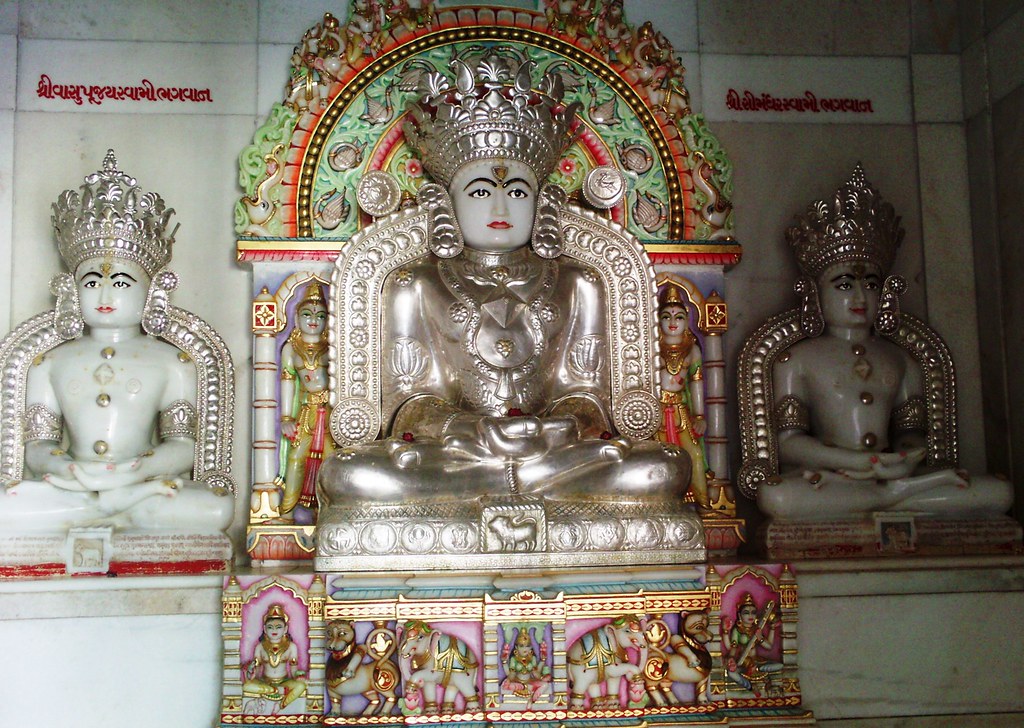There is so much wonderful material in this interview with Dr. Ellen Gough.
I resonated deeply to Dr. Gough’s methodology, tracing a specific ritual practice through time (rather than focusing on a particular sect or historical era). This approach is very similar to work I did in chapters of my own book on Nepali royal ritual—but I have never thought to frame the approach as Dr. Gough does, as a crucial strategy to grasp the complex multi-religious histories of South Asia. I also particularly appreciated how Dr. Gough defined tantra as the targeted destruction of karma, and then put that definition side-by-side with a description of the Jain idea of a luminous perfected soul weighed down by physical karma. This pairing of explanations helped me to understand in a fresh way the common tantric claim that serious practice can result in super-human powers (such as “the ability to fly, …clairvoyance, …the ability to cure people with their bodily fluids”1).
Most importantly, though, I simply find the topic of Dr. Gough’s forthcoming book to be fundamentally important. It is complicated, even counter-intuitive, to include Jainism in the broader discussion of the development of South Asian tantra, and it still seems quite remarkable to me that Jains should have embraced any form of tantrism at all.
In order to gain entry into the fundamental question as to how and why Jains took to tantra (and what this can tell us about religious processes more generally), I want to pause over an apparently minor detail from the podcast: namely, that the Jain adoption of tantra appears to begin with lay people.
Dr. Gough indicates that Jain manuals seem to start including tantric mantra-practice right at the times when monastic mendicant communities are proliferating—because that is the time when mendicants need to compete with one another in order to receive lay patronage. Ascetic mendicants need temples, facilities, food, and material support; lay Jains are positioned to provide them; therefore ascetic mendicants must impress and appeal to lay people in order to secure their patronage.
This point seems important and surprising to me for two reasons. First, it reverses the direction of religious innovation that one might expect. Jains themselves tend to think of their religious knowledge as one-directional—from sacred texts to mendicants to lay people—and it is very common for lay Jains not only to defer personally to ascetics but to refer inquisitive foreign scholars to the proper authorities to get their questions answered.2 Religious studies scholars, too, often presume that religion ‘really’ happens at the level of religious authorities and the texts they write. This might encourage people to assume that new religious ideas or practices start with experts and filter downward to the masses; instead, it is noteworthy here that Dr. Gough insists it was lay people who drove religious innovation.
Second, it seems to me that Dr. Gough might actually be hinting at a more general mechanism operating in South Asian religious history. Is it possible that there are in fact many cases where lay-practitioners within one community have observed some other religion’s practices, and expressed interest/demand for something similar in their own tradition?
It is striking in South Asia how much continuity and similarity there is between the practices of ostensibly separate religions. There is obvious cognate similarity between the puja-rituals found in Hindu mandirs, Jain derasars, and Sikh gurdwaras (plus the Buddhist temples all over the Theravada world). South Asian religious communities have similar devotional singing traditions—similar astrological traditions—similar festivals and processions. Has Dr. Gough put her finger on the process that allowed that to happen? Have lay people, throughout history, been driving a broad process of borrowing, imitation, and mutual invention? If lay Jains were looking at Hindu or Buddhist tantric experts and asking for mantra-expertise from their own authorities… is it also possible that lay Buddhists were looking enviously at Hindu goddesses and asking their own authorities for feminine Buddhist deities? Is it possible that non-priestly Hindus were looking enviously at Jain dietary practices, and demanding a Hindu form of “pure-veg” purity? Might we be able to trace religious history in South Asia as a complex laity-driven process of ‘keeping up with the Joneses’—or better, ‘keeping up with the Joshis’?
If so, though, we would still need to identify how members of each tradition innovate in ways that are distinctive to their own communities and core commitments. And this is where Dr. Gough’s project is especially important, because she is demonstrating that while Jains do hop onto the tantra bandwagon… they keep clear limits on how much they want to adopt.
Why did Jains adopt some forms of tantra, but not others?
Dr. Gough distinguishes two types of tantra: mantra-based practice (using powerful words/sounds), and transgression-based practice (using powerful rule-breaking). According to her account, Jains join Hindus and Buddhists in adopting the former… but resist adopting the latter. They enthusiastically embraced mantras, but had no appetite for the antinomian (or “left-handed”) forms of practice.
In the interview, Dr. Gough appears to equate transgressive tantra with ritualized sex. But we might actually get more traction for understanding Jain skepticism if we consider the enormous emphasis in both Hindu and Buddhist antinomian traditions on food and the ritualized consumption of impure substances.
Whereas tantric sex requires practitioners to develop equanimity in the face of pleasure, transgressive food requires practitioners to overcome disgust. Aghori sadhus are said to eat flesh from human corpses, and drink from bowls made of human skulls; the ‘left-hand’ goddess Matangi can be offered taboo leftover-food from her devotees’ plates. The daily nitya-puja for Kaula tantrics involves preparing a three-ingredient mix of wine, meat, and sexual-fluid.3 On the Buddhist side, there are tantric texts that exhort readers to perform rituals involving “the so-called ‘five meats’ (māṃsa)… beef, dog, elephant, horse, and human flesh” as well as the “‘five ambrosias’ (amṛta)… faeces, urine, blood, semen, and marrow.”4
It seems frankly inconceivable that Jains would adopt this kind of transgressive food-based practice. Jains invest eating with an extraordinary religious weight. For Hindus and Buddhists, food is a matter of convention and ritual/monastic purity, but not usually an issue of karma. For Jains, food is a constant source of karmic ‘dirt’ on the soul. Because food comes at the expense of non-human lives, eating itself entails violence (himsa)—and is thus ultimately an impediment to Jain salvation. To limit this impediment, Jains pay meticulous attention to what they eat. All Jains are expected to be vegetarians, and to restrict their diets in varying ways; most Jains (mendicant and lay alike) undertake routine fasts. For Jains, dietary rigor is a point of pride, and a significant index of religious authority.
Where Hindu and Buddhist tantrikas could ‘wow’ their lay followers with their transgressive food practices, it seems impossible for a Jain ascetic to receive similar approval. A Jain ascetic who chose to eat dog-meat would not be signaling non-dual perception and equanimity to the world—they would be demonstrating a reckless disregard for karma, and for the soul-staining power of meat. They would be further clouding their soul with karmic particles, not releasing their soul’s ultimate luminescence.
If it was indeed lay Jains driving the tantric innovation, it makes intuitive sense that they would not have wanted their ascetics to undertake food-based transgression.
What this example indicates is that cognate traditions within South Asian religions are not a matter of simple borrowing or copying. Instead, members of each tradition must filter new innovations through their existing core practices and sensibilities—and adjust or reject pieces that fundamentally did not fit.
The story that Dr. Gough is telling about the development of Jain tantra—the Jain adoption of mantra-practice, but rejection of antinomianism—thus seems to me to be a fundamentally noteworthy case-study. Far from being a curiosity of Indian history, this development would appear to carry crucial implications for understanding how religions grow and change, how traditions in close proximity can simultaneously innovate together but maintain their respective distinctiveness.
References
- Quoted from the minute-mark-13:58 section of the podcast transcript.
- I have personally noted the tendency of lay Jains to defer to mendicants, and I think it has also been noted in passing in print—but I confess I cannot easily lay my hands on a citation. Perhaps Whitney Kelting’s work on Jain lay women (Singing the Jinas: Jain Laywomen, Mandal Singing, and the Negotiations of Jain Devotion (2001))?
- The Kaula daily ritual (nityapūjā).(last accessed May 16 2021).
- Christian K. Wedemeyer (2007) “Beef, Dog, and Other Mythologies: Connotative Semiotics in Mahāyoga Tantra Ritual and Scripture,” Journal of the American Academy of Religion, Volume 75, Issue 2, June 2007, Pages 383–417, https://doi.org/10.1093/jaarel/lfm006.



